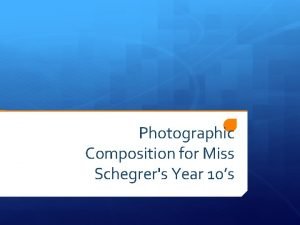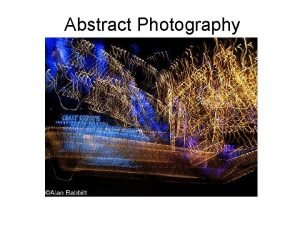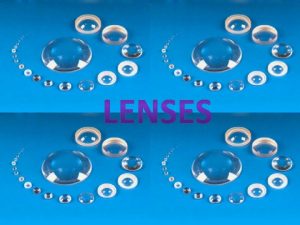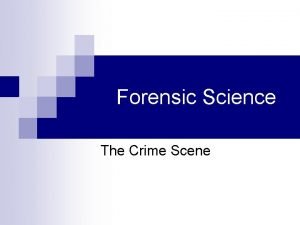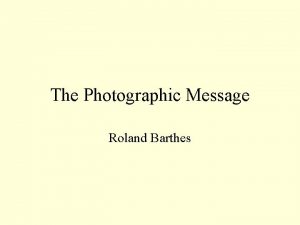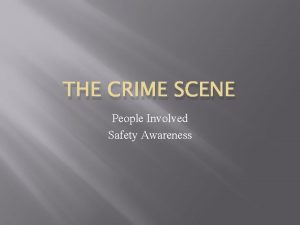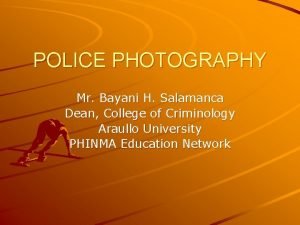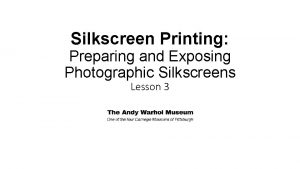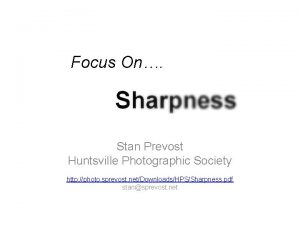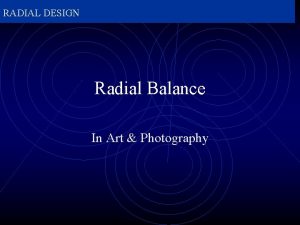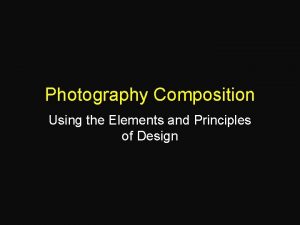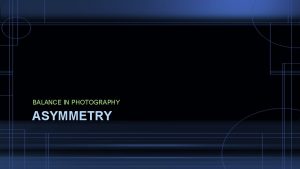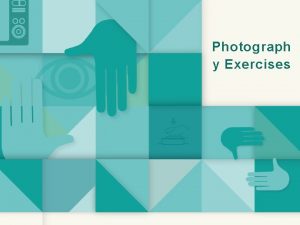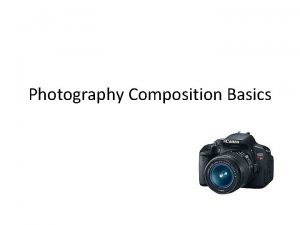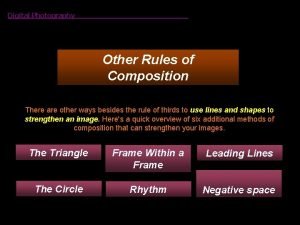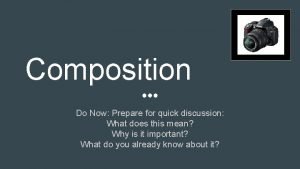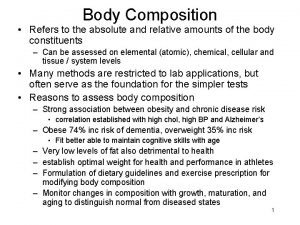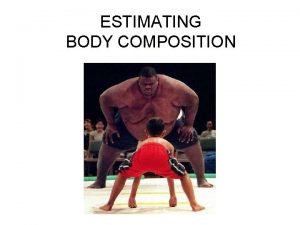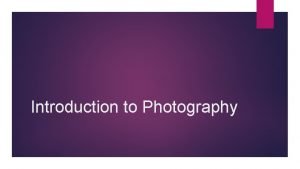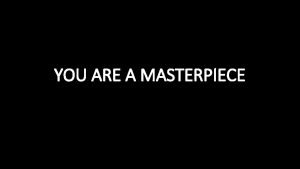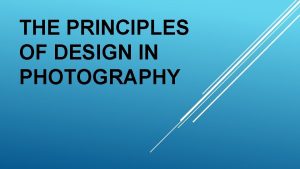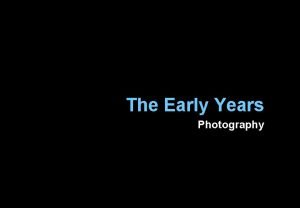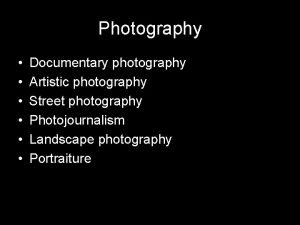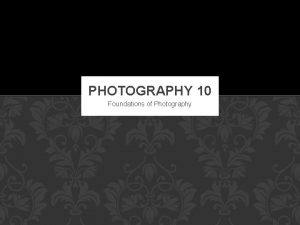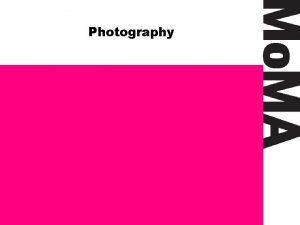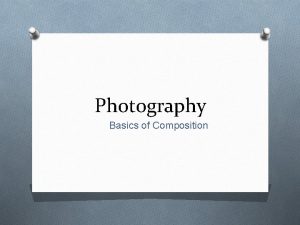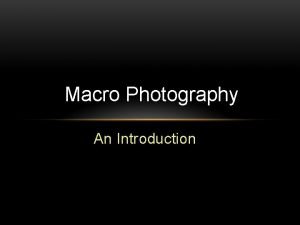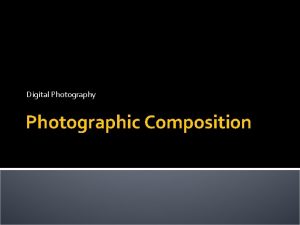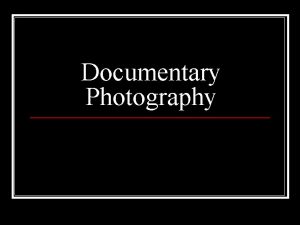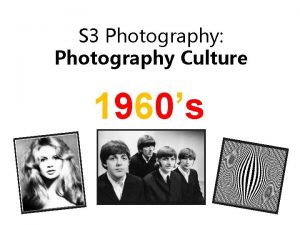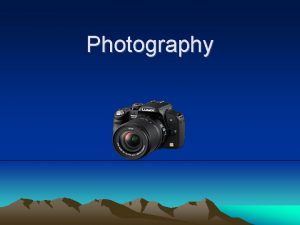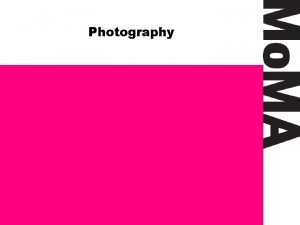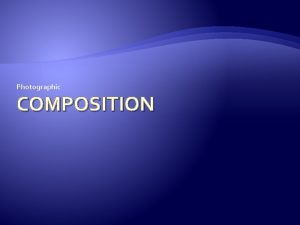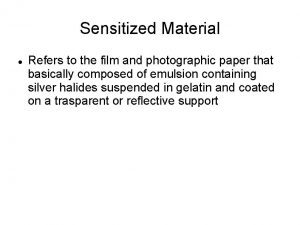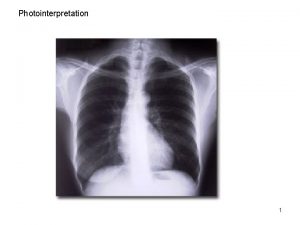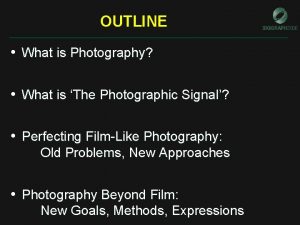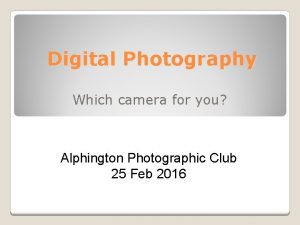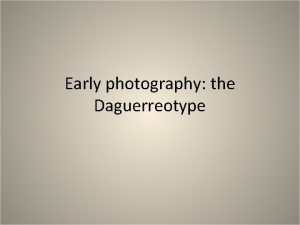INTRODUCTION TO PHOTOGRAPHY PHOTOGRAPHIC COMPOSITION Composition refers to



























- Slides: 27

INTRODUCTION TO PHOTOGRAPHY

PHOTOGRAPHIC COMPOSITION Composition refers to the content of a photograph-the way everything in the photo is laid out. Includes the subject matter, the relative size and positions of objects within the photo, lighting and tonal balance, etc Most rules about composition are simple The more you follow the rules at the beginning—the more natural you will become.

THE RULE OF THIRDS the frame is divided into nine imaginary sections creates reference points which act as guides for framing the image Points (or lines) of interest should occur at 1/3 or 2/3 of the way up (or across) the frame

KNOW YOUR SUBJECT Make sure you know exactly what it is you are photographing, i. e. have a clearly defined subject. Ex. If you are photographing a person and not the stuff in the background—concentrate on THEM— get closer or zoom. Don't have unnecessary empty or useless space in the photo (i. e. lots of sky)—if it serves no purpose.

THE FRAME Check the edges of the frame! Partial objects can be awkward or even confusing try to have a reason for including or excluding partial objects. It's especially important to notice how people in the background are framed —best not to cut them off in an unflattering way. Adjust frame to include them comfortably or leave them out altogether.

AVOID DISTRACTING OBJECTS If something in the photo attracts the eye more than the subject, try to compose the photo differently.

CAMERA ANGLES CLOSE-UP SHOT A certain feature or part of the subject takes up the whole frame. Usually means a close up of their face (unless specified otherwise). A close-up of a person emphasizes their emotional state.

MEDIUM CLOSE UP SHOT Half way between a Mid Shot and a Close Up. This shot shows the face more clearly, without getting uncomfortably close.

MID SHOT Shows some part of the subject in more detail while still giving an impression of the whole subject. Gives the feeling of you were having a casual conversation. You wouldn't be paying any attention to their lower body, so that part of the picture is unnecessary.

LONG SHOT The subject takes up the full frame, or at least as much as comfortably possible.

EXTREME CLOSE UP SHOT The Extreme Close Up gets right in and shows extreme detail.

OVER-THE-SHOULDER SHOT Looking from behind a person at the subject. helps to establish the position of each person get the feel of looking at one person from the other's point of view.

POINT-OF-VIEW SHOT This shot shows a view from the subject's perspective.

HIGH ANGLE SHOT “Bird’s Eye View” Shows the subject from above, i. e. the camera is angled down towards the subject. has the effect of diminishing the subject, making them appear less powerful, less significant.

LOW ANGLE SHOT shows the subject from below, giving them the impression of being more powerful or dominant.

EYE-LEVEL SHOT This is the most common view. It shows subjects as we would expect to see them in real life.

REVERSE ANGLE SHOT TWO separate video shots. “Coming and going” Ex. Filming a shot of a person walking down the street. A) Shot 1—person walking towards and up to camera B) Shot 2—person walking away from camera and further down the street.

TILTING a vertical camera movement in which the camera points up or down from a stationary location. For example, if you mount a camera on your shoulder and nod it up and down, you are tilting the camera.

BALANCE many types of "balance" in a photograph Ex. a mix of close and distant objects, a mix of light and dark, technology/nature.

LINES Look for different types of lines in the composition Ex. Buildings, poles, horizon Different lines have different effects: *Vertical lines emphasise strength, power and height. *Horizontal lines emphasise width, stability and security. *Diagonal lines have a more dramatic, dynamic effect than vertical and horizontal. *Curved lines reflect nature, relaxation, sensuality, etc.

Lines can be used to: *direct the viewer's interest, *emphasize parts of the frame, *generally create interesting effects.

VIDEO TECHNIQUES Basic photography techniques are used in video as well as a few special additions.

DOLLYING A dolly is a cart which travels along tracks Camera is mounted on the dolly and records the shot as it moves. Camera allows focus of shot to move IN and OUT while being followed. **Different from a Tracking Shot** Dolly shots have a number of applications and can provide very dramatic footage

TRACKING Usually, a video shot in which the camera is mounted on a cart which travels along tracks. often more narrowly defined as movement parallel to the action, or at least at a constant distance

PANNING a horizontal camera movement in which the camera moves left and right about a central axis. This is a swiveling movement, i. e. mounted in a fixed location on a tripod or shoulder

LIGHTING High Key: Dim background, bright light from above the subject, usually used in comedies. Super High Key: Dark background, bright light from above. Starkness, sterile environment, lifelessness

Low Key: Dim lighting (glowing candlelight). Sombre lighting, usually used in film noir or mystery films. Backlighting: Dark background. The source of light is behind the object being filmed. We only see his/her silhouette.
 What is “photographic composition”? *
What is “photographic composition”? * Is abstract photography same as conceptual photography
Is abstract photography same as conceptual photography Ray diagram of convex lens
Ray diagram of convex lens What is forensic photography?
What is forensic photography? Roland barthes the photographic message
Roland barthes the photographic message Sketch preparer
Sketch preparer Different photographic rays
Different photographic rays Photographic silkscreen
Photographic silkscreen Stan
Stan Radial balance photography
Radial balance photography 10 elements of photography
10 elements of photography Symmetrical balance photo
Symmetrical balance photo Photography composition exercises
Photography composition exercises Viewpoint composition photography
Viewpoint composition photography Viewpoint composition photography
Viewpoint composition photography Diagonals and triangles photography
Diagonals and triangles photography In a work of art the word composition refers to
In a work of art the word composition refers to Composition refers to
Composition refers to Body composition refers to
Body composition refers to Endomoph
Endomoph Composition techniques in photojournalism
Composition techniques in photojournalism Endomoph
Endomoph The simplest or the literal definition of photography
The simplest or the literal definition of photography Intro paragraph layout
Intro paragraph layout Statue of votive figures
Statue of votive figures What is proportion in photography
What is proportion in photography Elements of art: color
Elements of art: color Early years photography
Early years photography
